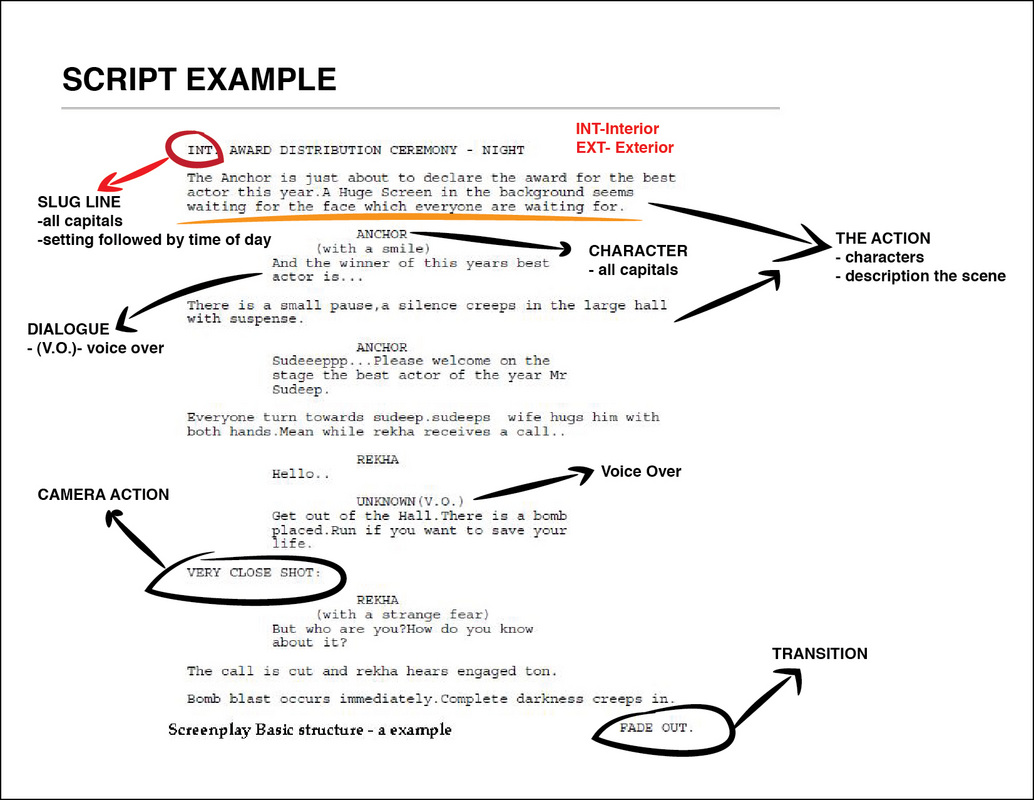

When introducing a character for the first time, however, it’s often useful to offer one to two lines of description to help give readers a fuller sense of their personality or appearance, such as: In the FIRST PAGE example above, Teacher’s description is quite simple: Scrawny. It’s always justified left, and looks like this: Action is always written in the present tense, and in most cases follows standard rules of capitalization and punctuation. This is where you can fill in details for your location, and explain what your characters are doing RIGHT NOW. Remember: A new slug line is needed every time you start a new scene-so you will be writing a lot of these! Occasionally, you’ll need a SUBLOCATION to clarify the location.

and LOCATION, then space, hyphen, space between LOCATION and TIME. Avoid overusing demarcations like DUSK, MORNING, MIDNIGHT, or LATER. Usually just DAY or NIGHT, but can also be a specific time, like 3:00 PM, if it’s an important detail to the plot. Don’t worry-they’ll be room for the fun stuff later! These should be short, and avoid emotive description. If it’s both, such as when a bird shatters through a window into a kitchen, you can write INT./EXT. to demarcate whether the scene takes place inside (INTERIOR) or outside (EXTERIOR). Every scene you write MUST start with a slugline, and each slugline is made of three parts: Sluglines starts at a margin set 1.5-inches from the left side of each page, and setup a scene by describing WHEN and WHERE that scene takes place. In the PAGE ONE example above, the first SCENE began with this slugline:

A new scene will begin anytime YOU CHANGE LOCATION or SKIP FORWARD OR BACKWARD IN TIME, and each of your scenes will be made up of four basic elements: The basic building block of any script is a SCENE. It is the industry standard, and experimenting with other fonts only shows readers that you don’t know what you’re doing-and that’s a bad thing! Hollywood is a nostalgic industry, and we like our scripts to look like they came out of an Underwood. Okay, ready to try this for yourself? When it comes time to start laying word to page, here’s what you’re gonna want to do:ĪLL of the text in your screenplay must be typed in 12-point Courier (or Courier Final Draft) font. There are many different genres of film, but every film script uses the exact same FORMAT. This is an actual page from an actual script. It will be difficult to understand screenplay formatting if you have not already studied some actual script-pages, so for those of you in that category, please take a minute to read over the following PAGE ONE EXAMPLE: The rule of thumb when writing screenplays is that ONE PAGE EQUALS ONE MINUTE, so a two-hour film is approximately 120 pages, an hour-and-half film is approximately 90 pages, etc. So-for those of you just starting out, who may not have access to screenwriting software, or who simply want to do things the old-fashioned way, below is ScriptFaze’s official screenplay format guide: Turns out, for sixty years or so, screenwriters did a pretty decent job at formatting their own scripts using little more than their memories and a ruler. That said-there used to be this thing with buttons and ink ribbons and return levers called a ‘typewriter.’ I hear they were popular.
#Example of celtx script software
Writing software makes screenwriting an easier, faster process-but it’s also insurance against an unnecessary error that might doom your script to the scrap heap. I can honestly tell you that if a producer, agent, lit manager or other decision-maker in the industry picks up a script and finds any format error of any kind in the first couple of pages, that is as far they’re going to read. Formatting isn’t altogether tough, but getting it correct is imperative to getting your scripts read. It’s because if you’re getting serious about screenwriting, most writers take the jump into screenwriting software pretty quickly.įinal Draft is the gold standard, but occasionally you'll meet a writer still knocking ‘em out on ScriptBuddy, Celtx, or one of the myriad other Final Draft competitors. This is not because it doesn’t matter-it does.
#Example of celtx script professional
Before moving through the guide below, it’s important to take a minute and say that these days, most professional screenwriters (if not all) don’t spend much time thinking about screenplay format.


 0 kommentar(er)
0 kommentar(er)
